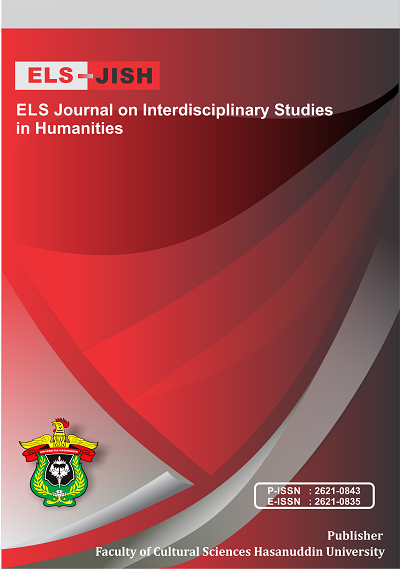EFL Teaching Material Development for Junior High Schools in Arfak Mountains Regency, West Papua
DOI:
https://doi.org/10.34050/elsjish.v5i2.21709Keywords:
EFL, Teaching Materials, Junior High SchoolAbstract
This Research discusses about teaching attractive materials that are suitable for the students and situation in Junior High Schools in Arfak Mountains Regency. This research aims to identify kinds of teaching attractive materials that suitable to the students and situation in Junior High Schools in Arfak Mountains Regency, and to indicate some types of teaching attractive materials chosen that can be developed by English teachers concerning to availability of the equipment needed in Arfak Mountains Regency. This research used Qualitative method, and the data is collected from observation or interview. The result of this research is found there are only some that might be able to be adopted to use in teaching English in SMP Arfak Mountain Regency. Those are realia, games (board race, Simon says, board jumble race, and hot seat), audio/tapes, and pictures. To develop those types of teaching materials, teachers are expected to be able to create their own teaching materials proposed.
References
Apsari, Y. (2017). The use of picture series in teaching writing recount text. Eltin Journal: Journal of English Language Teaching in Indonesia, 5(2), 51-56.
Asokhia, M. O. (2009). Improvisation/teaching aids: Aid to effective teaching of English language. International Journal of Educational Sciences, 1(2), 79-85.
Azarnoosh, M., Zeraatpishe, M., Faravani, A., & Kargozari, H. R. (Eds.). (2016). Issues in materials development. Springer.
BBC. (2011). ‘Realia’ Teaching English. Available: https://www.teachingenglish.org.uk/article/realia-0
Creswell, J. W. (2012). Educational research: planning. Conducting, and Evaluating, 260, 375-382.
Curtis, S. V., & Wodarski, J. S. (2015). The East Tennessee assertive adolescent family treatment program: a three-year evaluation. Social work in public health, 30(3), 225-235.
Celce-Murcia, M. (2001). Language teaching approaches: An overview. Teaching English as a second or foreign language, 2(1), 3-10.
Eckert, P. (2004). Adolescent language. Language in the USA: themes for the twenty-first century, 6, 58-75.
Fionatankard. (2017). 10 Creative Ways to Get Your ESL Students Talking with Pictures. Available on July, http://www.fluentu.com/english/educators/blog/esl-describing-pictures-students/
Khudoyberdievna, S. Z. (2017). Teaching English through games. Научный журнал, 3(16), 53-54.
Kim, L. S. (1995). Creative games for the language class. In English Teaching Forum, 33(1), pp. 35-36).
Landers, R. N. (2014). Developing a theory of gamified learning: Linking serious games and gamification of learning. Simulation & gaming, 45(6), 752-768.
McKay, S. L. (2012). Teaching materials for English as an international language. Principles and practices of teaching English as an international language, 3(9), 70-83.
Mohan, S., & Chenoweth, S. (2011). Teaching requirements engineering to undergraduate students. In Proceedings of the 42nd ACM technical symposium on Computer science education (pp. 141-146).
Nilsen, B., Albertalli, V., & Albertalli, G. (2002). Introduction to Learning & Teaching: Infants Through Elementary Age Children. Taylor & Francis US.
Nemtchinova, E. (2005). Host teachers' evaluations of nonnative‐English‐speaking teacher trainees—A perspective from the classroom. Tesol Quarterly, 39(2), 235-261.
Öhman, M., Almqvist, J., Meckbach, J., & Quennerstedt, M. (2014). Competing for ideal bodies: A study of exergames used as teaching aids in schools. Critical Public Health, 24(2), 196-209.
Prihandoko, L. A., Tembang, Y., Marpaung, D. N., & Rahman, F. (2019). English language competence for tourism sector in supporting socio-economic development in Merauke: A Survey Study. In IOP Conference Series: Earth and Environmental Science 343(1), p. 012170). IOP Publishing.
Pesce, C. (2017). Realia; 9 Ways to Bring Real Life into the Classroom. Available: www.busyteacher.org/2842-realia-esl-classroom.html
Rahman, F. (2018). The Constraints of Foreign Learners in Reading English Literary Works: A Case Study at Hasanuddin University. Journal of Arts and Humanities, 7(2), 01-12.
Rasmuson, Elmer E. Library. (2017). Library Research Process. Available: https://library.uaf.edu/ls101research-process
Rao, B. M. (2014). Use of Media as an Instructional Tool in English Language Teaching (ELT) at Undergraduate Level Int. Journal of English and Literature, 5, 141-143.
Riazi, A. M., & Mosalanejad, N. (2010). Evaluation of Learning Objectives in Iranian High-School and Pre-University English Textbooks Using Bloom's Taxonomy. TESL-EJ, 13(4).
Said, M. M., Rita, F., Weda, S., & Rahman, F. (2021). English Language Performance Development Through Extracurricular Activities At Faculty Of Teacher Training And Education Tadulako University Palu. PalArch's Journal of Archaeology of Egypt/Egyptology, 18(08), 388-403.
Sawyer, S. M., Azzopardi, P. S., Wickremarathne, D., & Patton, G. C. (2018). The age of adolescence. The Lancet Child & Adolescent Health, 2(3), 223-228.
Salyers, F., & McKee, C. (2021). The Young Adolescent Learner, https://docplayer.net/30521960-The-young-adolescent- learner-fran-salyers-and-carol-mckee.html, last accessed 2021/03/26
Shemshadsara, Z. G. (2012). Developing cultural awareness in foreign language teaching. English Language Teaching, 5(3), 95-99.
Thring, A. S. (2001). Education, Manpower and Economic Growth. McGraw Hill. New York. University College Cork, Ireland
Tomlinson, B. (Ed.). (2011). Materials development in language teaching. Cambridge University Press.
Vernon, S. A. (2017). Why English Language Games are Essential in a Teacher’s Toolbox. Available: https://www.teachingenglishgames.com/Articles/Why_and_How_to_use_Games_in_Class.htm
Webster, N. (2022). A Common-School Dictionary of the English Language. BoD–Books on Demand.
Wright, A., Betteridge, D., & Buckby, M. (1984). Games for Language Learning. Cambridge University Press.
Yuniyarsih, P., & Saun, S. (2014). Using Picture Word Inductive Model (PWIM) to teach junior high school students in writing a descriptive text. Journal of English Language Teaching, 2(2), 192-199.
Downloads
Published
Issue
Section
License
Copyright (c) 2022 Sukristiningsih Sukristiningsih, Suardi Sahid

This work is licensed under a Creative Commons Attribution-NonCommercial-ShareAlike 4.0 International License.






